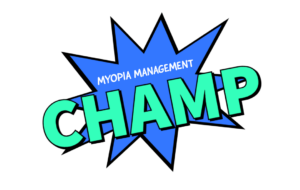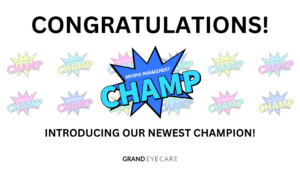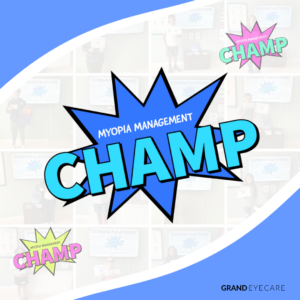September 15, 2023
By Grant Miller, OD
My goal with myopia management is to provide an experience. I’ve created the Myopia Management Champion Program, which educates every child as they gain confidence and recognize the importance of slowing myopia progression through the program.

Dr. Miller was a guest on WGN Daytime Chicago’s national television broadcast to educate viewers and parents on orthokeratology and the rising myopia concerns
My early clinical practice in a VA medical center was very isolated from the myopia management space. I did not start understanding or appreciating the pathology aspect of myopia until I began managing patients at a low vision and blind rehabilitation clinic.
In that role, patients came to me to create a plan to give them back independence through device evaluation, daily skills training, or vocational training. I would read through patients’ ocular history and find out that several had moderate to high levels of myopia before their diagnoses of glaucoma, macular degeneration, or retinal detachment. After evaluating the adult population for several years, I was given the opportunity to manage the pediatric population at the clinic. Once that happened, the conversation changed from how you can manage the problem in an adult to how you can limit its impact on a child.
Working in a low vision and blind rehabilitation center also gave me a lot of personal clarity on vision impairment. The reason: I have a 28 mm axial length. As a result, an undeniable amount of passion stems solely from my concerns about having myopia-associated vision loss.
Just Do It
My wife, fellow optometrist Dr. Eva Shabo, and I purchased Grand Eye Care, an established practice where we now practice full time. The prior owner of the office could have done more in the means of myopia management. There were a few patients already established on atropine. However, no other options were being offered to slow myopia progression. My mentality has always been that if I am going to do something, I will do it to the fullest of my ability for the patient. Shortly after acquiring the office, I began the certification process for a handful of the available orthokeratology lens designs so that I could incorporate more options into our patient care.
Implementing myopia management into practice was quite simple: I just did it. My personal experience with myopia and the clinical experience of managing vision impairment caused by myopia gave me the drive to limit the impact of myopia on every patient. Additionally, decades of clinical studies define myopia as abnormal in children, so our practice must utilize all available management options.
It started by changing the conversation on childhood myopia and educating any patient and parent who came into the office on why myopia is not normal in children. When a child or teenager is checked in, our questionnaire screens for lifestyle and behavioral tendencies to establish risk factors, and the parent is handed a flyer on myopia to review while they wait. During the exam, we use refractive error and axial length age-expected values on something I refer to as “the vision report card” to show where the child falls in relation to average or below-average findings. Parents are typically aware of growth charts from a pediatrician, so it does an excellent job of grabbing a parent’s attention on the issue of myopia progression. I finished the exam by mentioning that we can continue to prescribe stronger lenses, and their prescription will continue to increase, or we could slow down your child’s progression with myopia management.

Dr. Miller designed the Myopia Management Champion logo to have bright colors and mimic traditional superhero logos to get patients excited about the program.
Create an Experience
My goal with myopia management is to provide an experience. I’ve created the Myopia Management Champion Program, which educates every child as they gain confidence and recognize the importance of slowing myopia progression through the program. I want every child with myopia to have a blast while in the program. The program logo is brightly colored and brings excitement using elements from comic books or superheroes because I want them to become champions of their myopia.

All new Myopia Management Champion Program patients receive a certificate and a goodie bag and pose in front of this logo. Their picture circulates on the waiting room TV with other Myopia Management Champions.
For parents, I’ve created pamphlets and flyers that we provide at each examination. The pamphlet contains information on our Myopia Management Champion Program, highlighting the concerns, risks, and what we can do about myopia. The flyer uses a different approach to provide light but memorable exposure to myopia management. It uses only one to two sentences to explain: What is myopia? How does myopia management work? Why does my child need it? Early this year, we partnered with Hoot Myopia Care to continue the conversation of myopia management outside of the exam room. It has been a great addition to our myopia management program because it uses drip marketing to automatically send parents information on what we can do for their child’s myopia.
We also have myopia management showcases and events a few times during the year to bring additional awareness to myopia. Myopia vision simulators demonstrate refractive error changes or the visual complications of macular degeneration, glaucoma, and retinal detachment. We lay out orthokeratology and soft lenses, allowing parents and children to see, touch, and feel what they are. We even go a step further for a parent or child with additional interest and place an OrthoK or soft lens on the child’s eye to show that a child can actually wear a contact lens. Lastly, we measure the axial length and place it on a giant graph on the wall to compete for who has a normal axial length. It’s incredible how competitive children become when they want a lower number for their axial length than other children. Plus, we highlight our current champions at the events by giving them goody bags and having their “guest of honor” picture taken to play on the waiting room TV.

Patients photos are displayed on a TV in the waiting room, highlighting their participation in the Myopia Management Champion Program.
The Goal: Slowing Myopia Progression in Every Patient
The future of myopia management is dependent on every single doctor of optometry:
- Understanding that myopia is not a diagnosis of refractive error.
- Establishing myopia management as a standard of care for every child with myopia.
- Offering all available myopia management options that can benefit the patient — not just the ones that are convenient for you.
Many of us have already incorporated myopia management as a standard of care. However, I am hopeful that every single eye care provider around the globe will establish myopia management as a standard of care. Additionally, I’m hoping every eye care provider will offer all available myopia management options instead of relying on the most convenient option. When we settle for our own convenience, we are losing sight of our goal: to slow myopia progression in every child we encounter.
 |
Dr. Grant Miller owns and practices at Grand Eye Care in River Grove, Illinois. After launching a dedicated myopia management center in the office, he appeared on WGN Daytime Chicago’s national television broadcast to educate viewers and parents on orthokeratology and the rising myopia concerns. Dr. Miller is committed to changing the conversation about childhood myopia through a one-of-a-kind myopia management experience.
|













